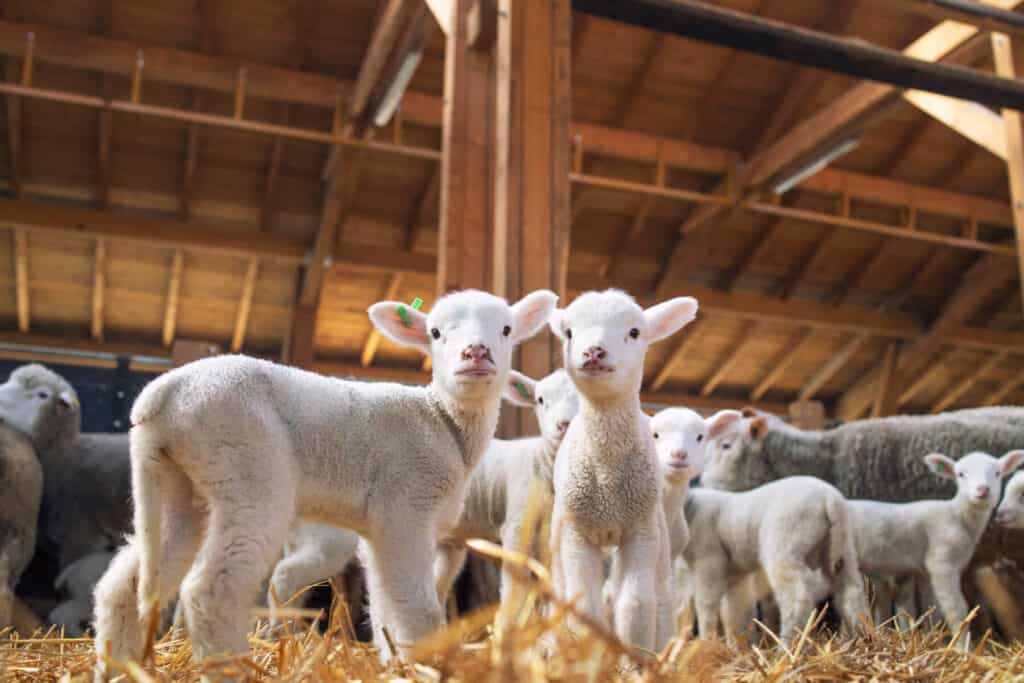Farms are businesses that raise animals. As farmers operate their businesses, they often grow food, too. Some of the food grown on farms feeds farm animals, and other food is sent from the farm to feed people. A visit to a farm might involve meeting many different animals that live there. You might see cows, pigs, chickens, horses, sheep, goats, llamas, and donkeys living on farms. Animals such as horses can also help with work on the farm, although farmers do most of this work with machines on modern farms.
Cows
A farm may raise cows for milk or beef. A dairy farm usually keeps many cows and milks them two or three times each day, collecting the milk to sell. Farmers feed cows a special mixture of grains that will keep them healthy and help them produce lots of milk. A cow might eat up to 100 pounds of food each day, and it may drink as much as 50 gallons of water. Farmers take good care of their cows to keep them healthy, often letting them roam in pastures during the day and when they aren’t being milked. Cattle raised for beef are not milked. Farmers take special care of the cattle to help them grow into big, strong animals. When the cattle grow to a certain size, farmers send them to a different market facility. Cows on a farm usually sleep in barns.
Pigs
Some farmers raise pigs. A female pig is called a sow, and a male pig may be called a boar. Farmers usually keep pigs indoors so they can care for them carefully. An average pig may grow to weigh between 600 and 900 pounds, but some pigs can weigh as much as 1,000 pounds. Pig farmers take special care of pigs, feeding and watering them, so they grow and stay healthy. Once pigs are old enough and big enough, a farmer sells them and they leave the farm.
Chickens
Some farms have chickens, either for eggs or meat. Chickens on a farm need a chicken house to keep them safe from other animals. If chickens have an outdoor area for wandering, they usually stay healthier and happier. Chickens also like to scratch and forage, so some farmers give them an outdoor place with mulch on the ground. Hens, female chickens, will produce eggs, and the farmer collects them. A farmer who wants to raise chicks will need hens and a rooster, a male chicken. The hens will lay eggs, and the farmer can either leave them with the hens for hatching or collect them to hatch them in an incubator.
Horses
Horses on a farm might live in a pasture, or they may live in a stable. If horses live in a stable, the farmer takes care of them to feed them and keep them clean. Horses might also live out in a pasture where they can eat and run around a large fenced area. Horses usually like living in a pasture because this is a natural setting for them. Farmers need to check on horses regularly if they live in a pasture to make sure they stay healthy.
- Saddling the Horse
- Equine Science for Kids
Sheep
Some farmers raise sheep for wool. Sheep need hay or grass to eat and lots of fresh, clean water to drink. Sheep also need special minerals to help keep them healthy. Farmers usually place sheep in a barn to sleep, and they allow sheep to run in a pasture during the day. Sheep-shearing usually happens every spring on a farm. A sheep-shearer will use a special tool to give the sheep a close haircut, removing the wool to sell it.
Goats
Farmers who keep goats on a farm usually raise them for milk. Goats eat hay or grass, and they need clean water throughout the day. Farmers keep goats in a barn at night to sleep, and the goats usually spend time in a fenced pasture during the day. Farmers will milk goats twice each day, in the morning and in the evening.
Llamas
Llamas can live on farms, too, although they are not a standard farm animal. Farmers might raise llamas for their wool. Llamas eat hay, grain, and grass, and they need clean water. Llamas need a shelter for sleeping, and they usually like to spend time in a fenced pasture. Farmers usually shear llamas in a similar fashion to shearing sheep, in the spring of the year.
Donkeys
Donkeys may resemble horses, but they have different needs and behaviors. Donkeys on a farm usually have a friendly personality. Some farmers use donkeys to guard the farm because donkeys often feel protective of other farm animals. Donkeys like to eat hay and grass.
More Resources
Learning about farms can be an important way to learn about how farms help people. Without farms, people wouldn’t have food to eat. Farm animals help with food production, too. Explore farms and farm animals with these educational activities and games.
- Farm Unit Activities and Games
- Farm Buildings for Animals
- A Farm Field Trip Guide
- Old MacDonald Had a Farm



